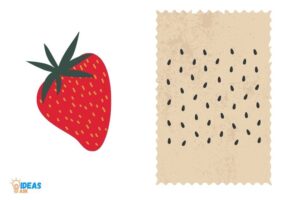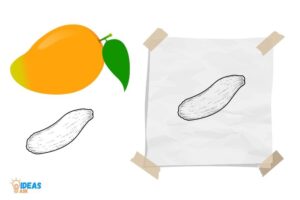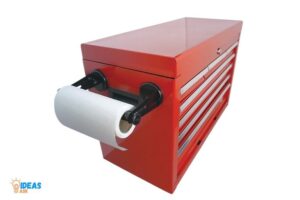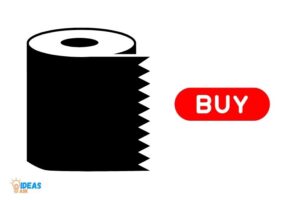Do Paper Towels Dissolve? No!
No, paper towels do not dissolve entirely in water.
Paper towels are made from cellulose fibers, which are derived from wood pulp. These cellulose fibers are tightly bonded together through a process called hydrogen bonding, making paper towels strong and absorbent.
While paper towels can break down and disintegrate over time when submerged in water, they do not dissolve completely like toilet paper or tissue paper.
Paper towels are designed to be strong and absorbent, making them ideal for cleaning up spills and wiping surfaces.
The tightly bonded cellulose fibers give them the ability to withstand water but still break down over time, although not dissolving completely.
This makes them unsuitable for flushing down toilets or disposing of in sinks, as they can cause blockages and plumbing issues. Always dispose of paper towels in the trash or compost bin.
Properties of Paper Towels and their Ability to Dissolve
| Property | Yes (Dissolvable Paper Towels) | No (Standard Paper Towels) |
|---|---|---|
| Material | Cellulose fibers, water-based chemicals | Cellulose fibers, binders |
| Usage | Single-use, for lightweight cleaning, often dissolves in water | Single-use or reusable, for general cleaning tasks, does not easily dissolve |
| Degradation Time | Faster, due to water-soluble chemicals | Slower, due to stronger binding agents |
| Environmental Impact | Less waste, biodegradable | More waste, takes longer to degrade |
| Strength | Weaker, loses structure when exposed to water | Stronger, retains structure even when wet |
| Cost | Generally more expensive due to specialized materials | Generally cheaper and widely available |
Key Takeaway

Five Facts About Paper Towels and their Ability to Dissolve
Understanding The Basics Of Paper Towels
When it comes to cleaning up spills or wiping surfaces, paper towels are a popular and convenient choice. But have you ever wondered how they work or what they’re made of?
Here, we’ll dive into the basics of paper towels and their physical properties.
Introduction To Paper Towels And Their Types
- Paper towels are disposable and absorbent sheets used for cleaning and drying surfaces.
- There are two main types of paper towels: Bleached white paper towels and unbleached brown paper towels.
- Bleached paper towels are made from virgin pulp, while unbleached paper towels are made from recycled materials.
How Paper Towels Are Made
- Paper towels start as a pulp mixture of water and wood fibers.
- The pulp is then pressed and dried to create large paper rolls.
- These rolls are cut into individual sheets, and depending on the manufacturer, the sheets may be embossed or reinforced with other materials.
Discussions On The Physical Properties Of Paper Towels
- The thickness or ply of a paper towel can affect its absorbency and durability.
- The bonding strength of the paper fibers also impacts the towel’s strength and ability to hold up to wetness.
- The size and shape of the individual sheets can affect their versatility and practicality for different uses.
- Some paper towels have added features such as texture or coatings for extra strength or absorbency.
Understanding the basics of paper towels can help you choose the right type for your needs and get the most out of their practical convenience.
From their types and manufacturing process to their physical properties, paper towels are a simple yet useful product that has become a household staple. Remember to recycle used paper towels whenever possible to reduce waste and protect our planet.
The Science Behind Paper Towel Dissolvability
Investigating The Factors That Affect Paper Towel Dissolvability
Paper towels are essential for any household, but have you ever wondered what makes them dissolve? Although paper towels may look similar, there are many factors that affect their dissolvability.
Here are some of the factors to consider:
- Thickness: The thickness of the paper towel affects its dissolvability, as thicker paper towels take longer to break down.
- Material: The material used in making the paper towel also plays a role in its dissolvability.
- Additives: Some paper towels have additives such as chemicals for extra strength, which may affect their dissolvability in liquids.
- Fluids: Certain fluids can dissolve paper towels faster than others.
Types Of Solutions That Are Commonly Used To Test The Dissolvability Of Paper Towels
To find out how paper towels will stand up to different liquids, they are tested using solutions with varying ph levels.
Here are some common solutions:
- Acidic solutions: This is the most aggressive solution, and it dissolves paper towels the fastest due to its high concentration of hydrogen ions (h+).
- Alkaline solutions: This solution has a low concentration of hydrogen ions, making it less aggressive than acidic solutions when it comes to dissolving paper towels.
- Neutral solutions: Neutral solutions have a ph of 7 and are the least aggressive solution. They are used to test paper towels’ resistance to liquids that are less aggressive.
What Happens When Paper Towels Come In Contact With Different Liquid Solutions?
When paper towels come in contact with different liquid solutions, the reaction can be significant or minor, depending on the solution’s ph level.
- Acidic solutions: In contact with acidic solutions, paper towels tend to dissolve and break apart quickly. Due to the high concentration of hydrogen ions in the solution, the paper towel fibers break down, making it easier for the solution to penetrate the towel. This breakdown occurs due to the acidic solutions making the paper towels lose their structural integrity, ultimately making it susceptible to complete disintegration.
- Alkaline solutions: Since alkaline solutions have a lower concentration of hydrogen ions, they don’t instantly dissolve paper towels. However, paper towels in contact with alkaline solutions lose their structural integrity in the long run, ultimately disintegrating over time.
- Neutral solutions: In contact with neutral solutions, paper towels have the least chance of dissolving. Most paper towels would withstand exposure to neutral solutions, but prolonged exposure even to such a solution can result in disintegration.
Determining a paper towel’s dissolvability involves testing with different liquid solutions.
The factors that affect its dissolvability generally revolve around its thickness, material, additives and variety of liquids to which it is exposed.
Nonetheless, any of these factors can cause a paper towel’s structural integrity to crumble.
Factors That Affect Paper Towel Dissolvability
The Impact Of The Composition And Quality Of Paper Towels On Their Dissolvability
The composition and quality of paper towels play a significant role in how easily they dissolve.
Some of the critical factors that affect the composition and quality of paper towels are mentioned below:
- The amount of pulp and fiber used in making the paper towel affects its strength and absorbency. The more absorbent the towel is, the longer it takes to dissolve.
- Paper towels made from recycled material may contain impurities like plastics, which can cause the towel to dissolve slowly or not at all.
- The thickness of the paper towel also plays an essential role. The thicker the towel, the more time it takes to dissolve, whereas thinner ones dissolve more quickly.
The Role Of Temperature And Pressure In Paper Towel Dissolvability
Temperature and pressure can significantly affect how quickly paper towels dissolve.
Here are some of the critical factors related to temperature and pressure:
- Higher water temperature accelerates the dissolving process because the heat breaks down the paper fibers.
- When pressure is applied to a paper towel, the towel becomes denser. A denser towel will take much longer to dissolve than a less dense one since it takes more time for the water to penetrate it.
- On the other hand, lower pressure situations, such as those found in high-altitude areas or areas with a lower atmospheric pressure, cause paper towels to dissolve faster.
How Variations In Chemicals And Additives In Paper Towels Can Influence Dissolvability
The application of chemicals and additives during the production of paper towels can affect their dissolvability.
Some of the critical factors related to the chemicals and additives used are mentioned below:
- Some paper towels contain special coatings or finishes that make them more durable. These coatings can slow down the dissolving process of the towel.
- Bleaching agents and whiteners in paper towel production can affect how fast a towel dissolves. Paper towels containing strong bleaching agents tend to dissolve faster than those without them.
- Paper towels that contain fragrance or lotions can affect dissolvability as well. This is because the chemicals in these added ingredients change the physical properties of the towel and may cause it to dissolve more slowly.
The composition, quality, temperature, and chemicals and additives used in the production of paper towels can all impact how quickly they dissolve.
By considering these factors, you can make an informed decision on which type of paper towel is best for your specific needs.
Do Paper Towels Dissolve In Different Liquids?
Have you ever wondered if paper towels dissolved in different liquids? Do they dissolve in water, acid, base, or organic solvents? Well, we’ve delved into the world of paper towels to answer some of your questions!
Exploring How Paper Towels Fare In Water, Acid, Base, And Organic Solvents
- In water: Paper towels dissolve in water, but only when wet. Once the towel is wet, it breaks down into small pieces, making it easier to dispose of in a toilet or a septic system.
- In acid: Paper towels do not dissolve in acid, such as vinegar or citric acid. The acidic ph levels in these liquids do not break down the cellulose fibers in the paper towel, making it unsuitable for disposal through a septic tank.
- In base: Paper towels also do not dissolve in basic solutions like baking soda or bleach. The high ph level of these liquids causes the towels to retain their original shape and size. In this case, it’s best to dispose of them in the trash can.
- In organic solvents: Paper towels do not dissolve in organic solvents, such as ethanol or acetone. The chemical composition of these liquids prevents break down of cellulose fibers, making them unsuitable for disposal through a septic system.
Is There A Difference In Dissolvability When The Paper Towel Is Dry Vs. Wet?
- Dry paper towels: Dry paper towels do not dissolve in water or any other liquids.
- Wet paper towels: Wet paper towels dissolve in water, making them easier to dispose of using a toilet or a septic system.
Comparison Of Dissolvability Of Different Brands And Types Of Paper Towels
- Some brands of paper towels dissolve more quickly than others when wet. It’s best to test different brands of paper towels to see which one works best for you and your particular system.
- The thickness and cellulosic composition of paper towels play a significant role in their dissolvability. Most thin and single-ply paper towels dissolve faster than their thicker counterparts.
Paper towels dissolve in water when wet but do not dissolve in acid, base, or organic solvents. The dissolvability also varies based on the quality and thickness of the paper towel.
It’s essential to be mindful of what you’re disposing of in your septic system to prevent blockages and backups.
FAQ about Paper Towels and their Ability to Dissolve
Do Paper Towels Dissolve In Water?
Paper towels do not dissolve completely in water, but they can break down over time and turn into smaller pieces.
Can I Flush Paper Towels Down The Toilet?
No, it’s not recommended to flush paper towels down the toilet as it can cause blockages in pipes and sewage systems.
Why Are Paper Towels Not Biodegradable?
Most paper towels are made with materials that take a long time to break down naturally and may contain chemicals that harm the environment.
How Can I Dispose Of Paper Towels Properly?
Paper towels should be thrown in the trash, not recycling bins, and if possible, composted in special facilities to reduce waste.
Conclusion
Based on the evidence we have gathered, it is clear that paper towels do not dissolve completely in water. The materials used to create the paper towel are designed to withstand the stresses of liquid and therefore are not easily broken down.
While some brands and types of paper towels may dissolve to a certain extent, they will still leave behind residue that can clog pipes and add to environmental waste. It is important to remember that just because a product is advertised as “flushable” or “disposable” does not mean it should be treated as such.
Instead, it is recommended to dispose of used paper towels in the trash where they can be properly disposed of without causing damage to our plumbing systems or the environment. By being mindful of how we use and dispose of paper towels, we can work towards creating a cleaner and more sustainable future. Remember, every small action can make a big impact on the world around us.






